Watching Small Drones in the Israel - Palestine Conflict
Some initial impressions from watching DJI and other drones in the air above Israel and Gaza
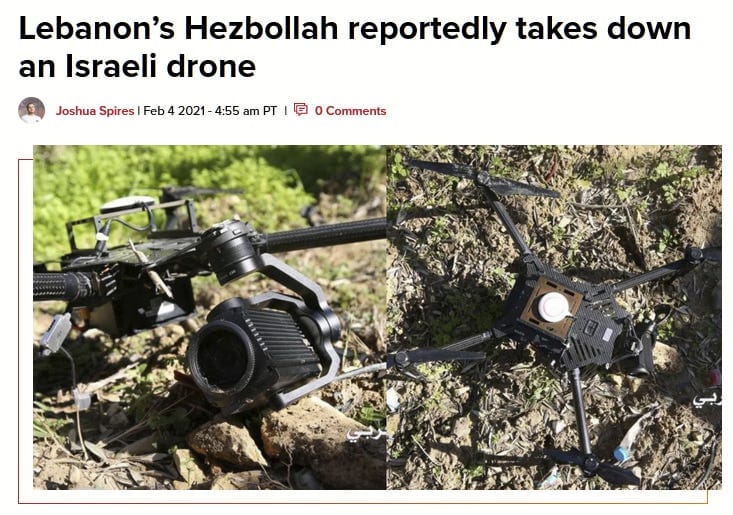
I lack both the qualifications and the words to comment in general geopolitical terms on the horrifying explosion of violence in Palestine and Israel this month. Other than that there is never any justification for intentionally killing civilians, no matter how good an excuse you say you have for doing it,
I do have some thoughts on what’s going on with drones.
Drones Still Don’t Wear Uniforms. And They Still Really, Really Should.
It’s 2023, and we still have no standard, universally accepted way to tell consumer drones apart in the air. Unlike the many mechanisms that allow people on the ground to figure out if a manned aircraft belongs to your side, the other side, or is piloted by a neutral actor, our tools for doing the same thing with drones are fragmented, brand-new, and distinctly untested in war time situations.
What’s more, current norms-based international humanitarian law that’s pertinent to air warfare largely doesn’t account for the existence of capable aircraft without a human pilot in them.
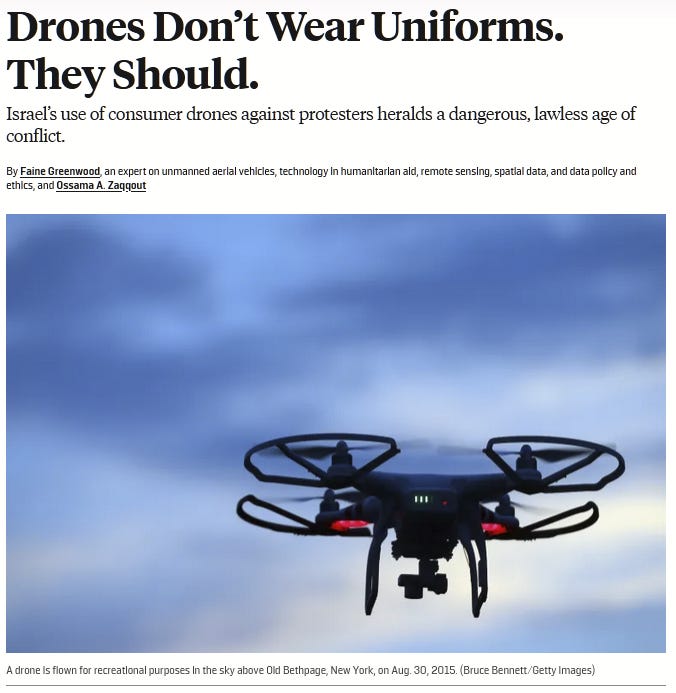
I’ve been worried about this issue for a long time: in 2018, I wrote a Foreign Policy article with a Palestinian colleague about drone mistaken identity, with the Gaza border protests of that era as the backdrop. At the time, Israel was piloting large DJI Matrice 100 drones (a model designed for film-making) that had been modified to drop tear gas canisters over the border into Gaza, a practice that brought up a rather large number of international humanitarian law questions.
Strikingly, then Israeli Defense Minister Avigdor Liberman attempted to attribute the death of a Palestinian photojournalist to the fact that he’d been using a drone, claiming “I don’t know who is or isn’t a photographer. Anyone who operates drones above IDF soldiers needs to understand he’s putting himself in danger.” (The journalist, Yasser Murtaja, was not using a drone at the time of his death, but Liberman didn’t know that).
In other words, Liberman was attempting to argue in 2018 that simply using a drone in airspace the IDF happens to be operating in is enough to make you a legitimate target - a legal argument that is worrisome indeed for the many reporters, humanitarian aid workers, and other civilians who now regularly operate drones in disaster and conflict today.
The IDF also was using commercial DJI Mavic drones as early as 2017 for border defense operations - and continued to do so even after the US Army officially banned its fighters from using the Chinese products. Insofar as I can determine (and I’d appreciate it if you let me know otherwise), the IDF is still using DJI products today. As just one example of their current use, Lebanon’s Hezbollah claimed in 2021 that it shot down an Israeli DJI Matrice 100 drone that was flying above the UN-imposed Blue Line (and Israel claims that it regularly takes down DJI drones piloted by Hezbollah).
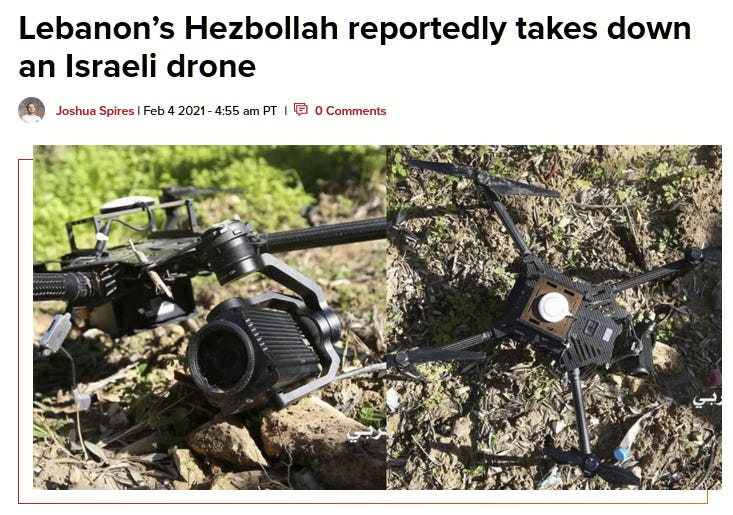
Today, as I write this, this pressing question about drones, identity, and IHL remains unanswered. When the Ukraine War began in early 2022, I wrote an article for the ICRC’s website speculating on where small drones fit into IHL. Since then, I’ve come across many, many examples of friendly fire incidents related to small consumer drones from both Russian and Ukrainian sources - a picture that’s complicated even further by the massive proliferation of electronic warfare and other counter-drone systems on modern battlefields.
Until we take action to globally discuss where small drones fit into IHl and how we can tell them apart in contested airspace, every civilian who operates a drone in conflict settings is going to be at very enhanced risk. I worry about the journalists and aid workers who are flying them right now over the conflict in Israel and Palestine.
There are also new technological considerations that could be relevant to IHL as well, like Israel’s drones which it claims are capable of mimicking cell towers, allowing Israeli forces to install spyware on enemy phones and track people into buildings. (The actual capability of these tools in real-world settings versus the hype remains unknown, though).
I hope that the world will finally start realizing that we need better ways to sort out whose drone belongs to whom, quickly.
Drones As Evidence Tools in War Crimes Disputes - Al Ahli Hospital
Drones are a remarkably efficient and inexpensive tool for capturing super-high resolution 3D maps and models of the real world, and crime scene investigators have been using them in this capacity around the world for, at this point, over a decade. War crimes investigators are also starting to follow suit, like those who reportedly used drones to map large extents of the Ukrainian city of Bucha after Russia retreated in April 2022.
Investigators are also evaluating drone video of potential war crimes, like this drone imagery shot by a Ukrainian during the occupation of Bucha, which appears to show a military vehicle shooting at an unsuspecting person on a bicycle. The international war crimes investigation world is still trying to figure out best practices and protocols for integrating drone-collected data into official investigations, but it’s clear that the practice is absolutely here to stay.
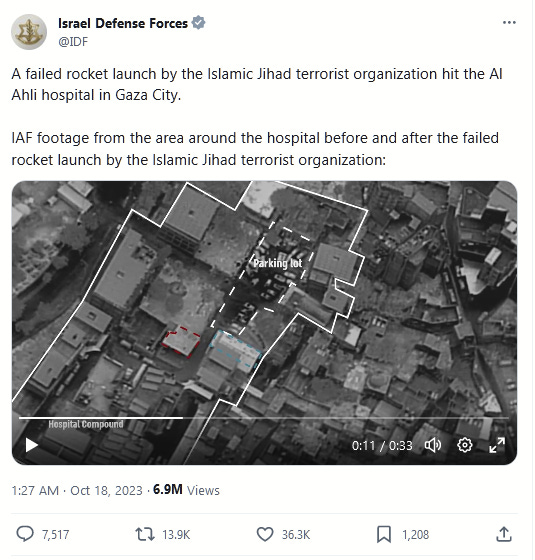
The IDF reminded us of this on October 18th, when it released fairly high quality drone footage, collected by an unknown (but almost certainly military-type) aircraft, of the damaged Al-Ahli Hospital and parking lot in Gaza, where Hamas says hundreds of people were killed in an air attack on Oct 17th. Hamas claims the IDF intentionally targeted the hospital, which is a blatant violation of human rights law: the IDF, meanwhile, counters that the damage was caused by a misfired Palestinian Islamic Jihad (PIJ) rocket, and is using its drone video to bolster its argument.
The IDF’s release of this footage is a phenomenal example of how drone imagery has become a truly mainstream tool that both nations and individuals can wield to counter existing narratives, or create new ones of their own. It’s also an indicator of how drone footage is inevitably going to be used to litigate war crimes claims in the future, in ways that will take place outside of the confines of traditional, formal legal mechanisms of investigation.
Nor is this the only drone imagery that the IDF has shared on social media and with journalists. As just one example, the IDF has publicly released footage from its recent retaliatory drone strikes in Gaza (see below), and night-time drone footage of an airstrike on the home of Ayman Nofal, who they claim was a senior Hamas operative: it’s also shared drone footage of communities destroyed by the October 7th Hamas attacks.
Israeli journalists and other actors have released drone footage of the aftermath of the Hamas attacks over the border within Israel, like this haunting aerial footage of the devastated Re’im music festival grounds, which was shot by an Israeli first responder organization. During conflict, the aerial view can be wielded in multiple ways.
Of course, drone footage is also coming out of Gaza.
Drone pilots there, including journalists and other actors, have released a constant stream of horrifying aerial footage of damage to civilian buildings from Israeli attacks, often sharing it on platforms like Telegram - footage which, like the Israeli drone videos, receives constant play in international media, highlighting the massive destruction Israel has already wrought in Gaza.
Like the IDF, Hamas has also intentionally released video of its own drone attacks on Israeli targets, in an effort to demonstrate its own technical expertise and command of modern tools. In this case, we see a grenade dropped by a small, likely Chinese (possibly DJI) drone, echoing the tactics we’ve seen over and over again since early 2022 in Ukraine and Russia.
While global media inevitably pays the most attention to drone warfare that involves grenades, no one should be ignoring how drone warfare is waged with information, either.
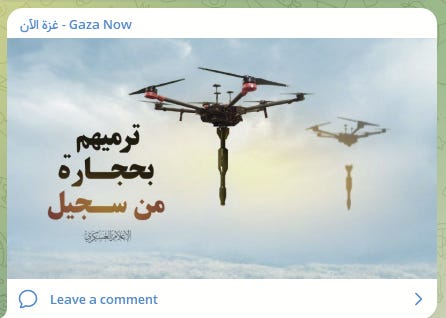
Just How Much Did Hamas Learn About Drones From Telegram?
Most every news story I’ve seen about how Hamas used small drones on October 7th converges on one key question: where did they learn to do that? Some sources claim that they learned it from Iran. Others, including a Ukrainian official, claim that Hamas fighters were trained in the modern art of consumer drone warfare by Russians, passing on information honed in battle since 2022.
While I certainly don’t know enough to discount any of these theories at this time, I do want to say this: it’s plausible that Hamas learned to fight with small drones, at least to the level it just demonstrated that it’s capable of, primarily by paying attention to Telegram.
As you probably know, I’ve constantly monitored both Russian and Ukrainian Telegram sources on small drone warfare since the conflict there began in February 2022. There’s a truly dizzying array of battle-tested information on drone warfare available there for anyone to view, from super detailed tactical breakdowns to open-source DJI drone hacks designed to counter electronic-warfare tools to a sea of instructional videos.
A relatively clever person familiar with Telegram and the relevant drone-centric sources could probably piece together a reasonably decent battle-drone strategy from this information alone. They’d also be able to find plenty useful information and highly relevant DJI hacks on the open Internet - many of them are posted on Github.
While foreign trainers familiar with the tactics would certainly be helpful - especially for more complex practices, like building and piloting small FPV kamikaze drones - they might not necessarily be required. Maybe it’s really not that surprising that Hamas knew how to (for example) disable RTH mode on the DJI drones they used to drop grenades on Israeli targets on October 7th. All it takes is someone on your side who’s reasonably good at Google.
Arguably, we can chalk up our present day dirt-cheap-drone revolution on the battlefield to two components: the existence of inexpensive and very easy to acquire consumer drone technology, and a social media world where it’s extremely easy to track down the inspiration and information you need to start fighting with them.
The IDF Has Been Using FPV Racing Drones For a Long Time
The IDF has been using consumer DJI products for a long time, but it’s also been taking advantage of cheap, hyper-fast and notoriously hard to pilot FPV racing drones for way longer than most people realize, too.
Back in 2018, the IDF was confronted with the thread of hundreds of “fire balloons” or kites launched from the Gaza Strip, low-tech explosive devices that nevertheless presented a major security headache. They hit on a then-novel idea: they’d recruit Israel’s best hobby FPV (first person view) racing drone pilots, and train them to use their cheap, nimble aircraft to smash into the balloons, reducing the threat.
Ultimately, they were able to recruit 15 drone pilots who had both the fast reflexes and the prior drone racing expertise to successfully do the job.
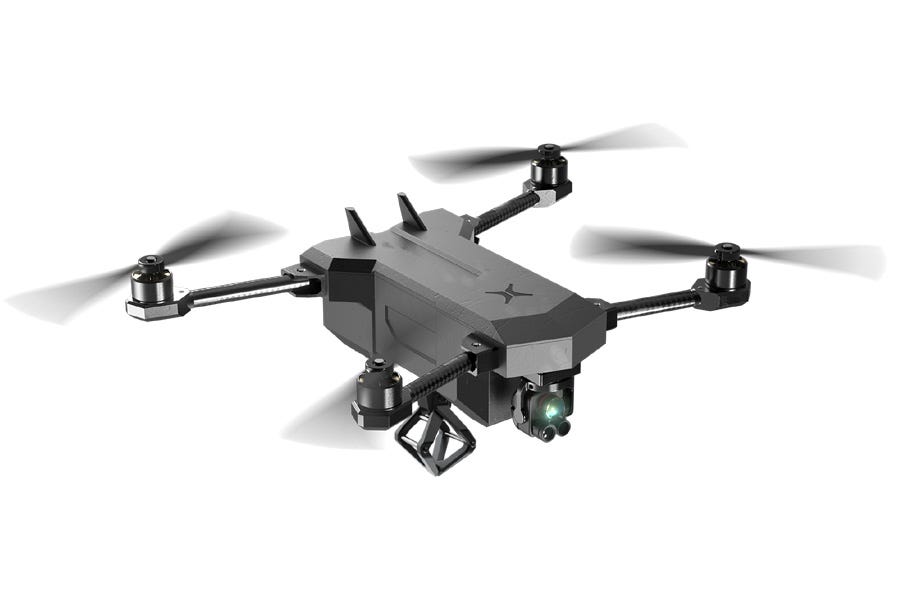
The drone pilots eventually launched their own startup company, Xtend, which builds small racing-type drones for explicitly military purposes - and have become so popular that the American armed forces are reportedly using them too.
What I don’t know is the price of these drones, which are almost certainly considerably more expensive than the $400 models put together with Superglue that have proven so effective in Ukraine and in Russia.
And as that war has demonstrated, being really, really goddamn cheap may be the single most crucial feature a small battle-drone can offer in 2022.
